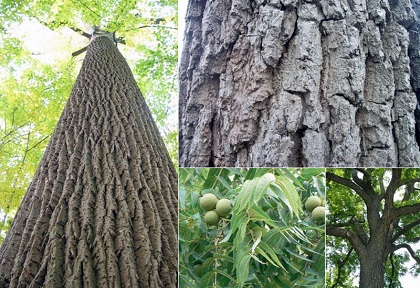The Tree Guy Logging & Tree Care
Page for Walnut Owners
Below is some information about what to expect if you choose to sell your walnut trees.
I talk to people all the time who have been severely misinformed as to the value of walnut lumber.
My hope is that this page might be able to clear some of that up. I've provided links below to some
sources that I consider knowledgeable and reliable. If you have questions or need more information on any of these topics, please send me a note
through my Contact Page and I'll do my best to get the information you request.
Iowa's Wood Industry
Quote from Missouri Conservationist article pp 20-21 Volume 74, Issue 2, February 2013
There are two basic levels of wood quality when dealing with black walnut : lumber grade and veneer.
There are several lumber-grade trees for every veneer-grade tree. That is why the veneer trees are
worth so much, they are rare. You may be able to determine if your tree is lumber or veneer grade by
examining the diameter of the tree, the height of the trunk before there is a limb, and the number of
defects on the trunk. The standard for measuring the diameter of a tree is at four and one-half feet above the ground,
on the uphill side of the tree.
To qualify for Grade A veneer, the tree would need to be at least 19
inches in diameter, or 60 inches in circumference. Although it is possible to sell a tree at this size,
it is a wiser financial move to keep the tree until it gains more diameter. For example, a black walnut
tree that is Grade A veneer at 19 inches diameter is only going to bring the owner seven to eight hundred dollars.
If the owner allows the tree to add another 6 inches of diameter, he or she can easily double that income.
Field or Forest: A black walnut tree grown in a field or pasture is usually similar in value to a nice
oak tree grown in the forest. One reason for this is that the length of clear log (trunk with no limbs
or defects) is very important to the value of the tree. At least 9 feet of clear trunk is required to
make the good veneer grades. Many trees grown in open spaces will produce limbs low and in all directions
from the trunk. This may look nice for a yard tree, but it decreases the timber value. If the tree forks
into more then one trunk, or has limbs within 9 feet of ground level, it no longer qualifies as high-grade
veneer.
Link to full article below
The Value of Walnut
| diameter | 6' | 7' | 8' | 9' | 10' | 11' | 12' | 13' | 14' | 15' | 16' | 17' |
| 10" | 13 | 16 | 18 | 20 | 23 | 25 | 27 | 29 | 32 | 34 | 36 | 38 |
| 11" | 18 | 21 | 24 | 28 | 31 | 34 | 37 | 40 | 43 | 46 | 49 | 52 |
| 12" | 24 | 28 | 32 | 36 | 40 | 44 | 48 | 52 | 56 | 60 | 64 | 68 |

